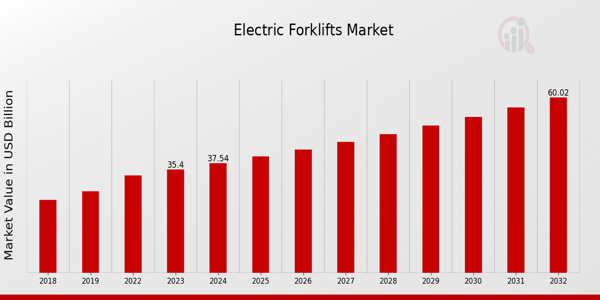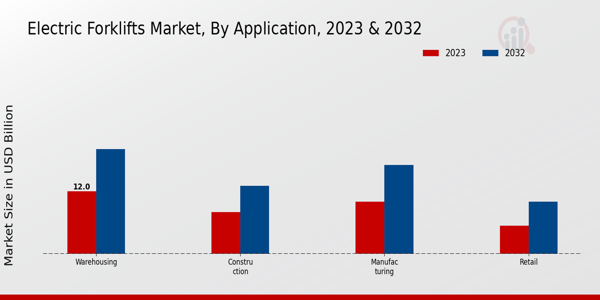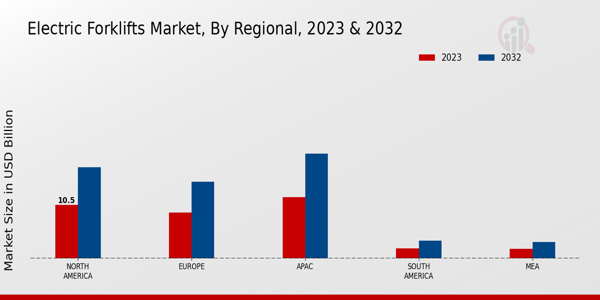Global Electric Forklifts Market Overview
The Electric Forklifts Market Size was estimated at 39.82 (USD Billion) in 2024. The Electric Forklifts Industry is expected to grow from 42.22 (USD Billion) in 2025 to 71.59 (USD Billion) by 2034. The Electric Forklifts Market CAGR (growth rate) is expected to be around 6.04% during the forecast period (2025 - 2034).
Key Electric Forklifts Market Trends Highlighted
The Electric Forklifts Market is experiencing notable growth, driven primarily by increasing demand for sustainable and environmentally friendly materials handling solutions. As industries seek to reduce their carbon footprints, electric forklifts offer a viable alternative to traditional diesel or gas-powered forklifts. Government regulations promoting emissions reductions also play a significant role in pushing businesses toward electric options. Furthermore, advancements in battery technologies enhance the performance and efficiency of electric forklifts, making them more appealing to a broad range of industries. Opportunities in the electric forklifts sector are emerging as companies expand their operations and invest in more efficient technologies.Automation and integration with smart warehouse systems present a chance for growth. Increasing adoption of electric vehicles and sustainability initiatives across industries can further bolster the demand for electric forklifts. Many businesses are looking to upgrade their logistics and supply chain processes, and electric forklifts fit well into this need by offering lower operating costs over time. Recent trends indicate a shift toward increased electrification of material handling equipment in warehouses and manufacturing facilities. The growing focus on health and safety in workplaces has led to a preference for electric forklifts due to their reduced noise pollution and lower emissions.Moreover, the rise of e-commerce is pushing companies to adopt more agile and flexible logistics solutions, including electric forklifts’ capability for quicker charging and their suitability for indoor operations. As the market evolves, responsiveness to customer needs and advancements in technology will continue to shape the landscape of electric forklifts.

Source: Primary Research, Secondary Research, MRFR Database and Analyst Review
Electric Forklifts Market Drivers
Growing Demand for Sustainable Solutions
As industries continue to place a greater emphasis on sustainability and reducing carbon footprints, the Electric Forklifts Market Industry is witnessing a significant uptick in demand for electric forklifts. These vehicles provide an environmentally friendly alternative to traditional internal combustion forklifts, producing zero emissions during operation. With increasing regulatory pressures and a collective push towards green technologies, many companies are opting for electric forklifts to align with their sustainability goals.The lower operating costs associated with electric forklifts, particularly in terms of energy consumption and maintenance, further boost their appeal. This trend is reflected in the projected growth of the market, where significant investment in electric forklift technology is expected to drive innovation and efficiency in warehouses and distribution centers, further enhancing workplace safety and productivity. Companies that adopt electric forklifts not only benefit from potential cost savings but also improve their corporate image, which is crucial in an era where consumers prefer environmentally responsible brands.The convergence of regulatory requirements and steady market growth is creating a favorable climate for electric forklift adoption across various sectors, thereby positioning the Electric Forklifts Market for robust expansion in the coming years.
Advancements in Battery Technology
The continuous advancements in battery technology play a pivotal role in enhancing the performance of electric forklifts in the Electric Forklifts Market Industry. Improved battery life and reduced charging times significantly increase operational efficiency and minimize downtime. The introduction of lithium-ion batteries has revolutionized forklift operations, offering longer run times, faster charging capabilities, and a longer lifespan compared to traditional lead-acid batteries.This ensures that businesses can rely on electric forklifts for extended periods without the constant need for battery replacement. Moreover, advances in battery recycling and energy management systems further augment the long-term sustainability of electric forklifts, making them an attractive option for logistics and supply chain operations. These technological innovations are crucial to unlocking the full potential of electric forklifts in various industrial environments.
Increasing Automation in Warehousing
The rise of automation in warehousing and logistics sectors is significantly driving the growth of the Electric Forklifts Market Industry. As companies invest in automated systems to enhance efficiency, electric forklifts are increasingly being integrated into automated operations. These electric vehicles often feature advanced technologies such as sensors and IoT capabilities, allowing for improved connectivity and real-time data management.
It has become evident that, as automation progresses and takes hold within the sphere of logistics, the combination of electric forklifts with complex warehouse management systems places electric forklifts as indispensable tools in today’s supply chain activities.
Electric Forklifts Market Segment Insights
Electric Forklifts Market Application Insights
The Electric Forklifts Market is notably segmented by application into key areas such as Warehousing, Construction, Manufacturing and Retail, showcasing diverse growth trajectories. The Warehousing application leads with a valuation of 12.0 USD Billion in 2023 and is projected to reach 20.0 USD Billion by 2032, reflecting its majority holding in the market. This growth can be attributed to the increasing demand for efficient material handling solutions driven by the rise of e-commerce and logistics sectors. Following this, the Manufacturing sector holds a significant position, valued at 10.0 USD Billion in 2023 with expectations to escalate to 17.0 USD Billion by 2032.The importance of electric forklifts in manufacturing cannot be overstated, as they facilitate precision and reduce the risk of accidents in factories. The Construction application, valued at 8.0 USD Billion in 2023 and anticipated to increase to 13.0 USD Billion by 2032, showcases its significant role in enhancing productivity on construction sites, where maneuverability and heavy lifting capabilities are essential. Finally, the Retail segment, though the smallest at 5.4 USD Billion in 2023, is projected to grow to 10.0 USD Billion by 2032, highlighting its unique need for compact and agile electric forklifts to manage inventory and streamline operations in stores.This segmentation of the Electric Forklifts Market reflects the varying demands across different industries, emphasizing how electric forklifts are becoming integral in optimizing operations and improving supply chain efficiency. Each application area brings unique challenges and opportunities, leading to continued innovation within the electric forklift industry to cater to specific operational needs across sectors.

Source: Primary Research, Secondary Research, MRFR Database and Analyst Review
Electric Forklifts Market Load Capacity Insights
This segmentation consists of capacities less than 3,000 lbs, 3,000 to 5,000 lbs, 5,000 to 8,000 lbs and over 8,000 lbs, each catering to specific operational needs. The segment of 3,000 to 5,000 lbs holds a significant position, being commonly used for warehousing and material handling tasks due to its versatility and efficiency. Meanwhile, the segment over 8,000 lbs is increasingly gaining traction, addressing heavy-duty operations in the manufacturing and logistics sectors.Growth drivers in this market include rising demand for eco-friendly solutions and an increase in e-commerce activities that require efficient materials handling. However, challenges such as the high initial costs and the need for regular maintenance can affect market growth. Still, opportunities arise from technological advancements in electric forklift designs and battery technologies, ensuring enhanced performance and lower lifetime costs. The overall market growth reflects these dynamics, further indicated by evolving Electric Forklifts Market statistics and data trends.
Electric Forklifts Market Power Source Insights
The segmentation of this market includes various sources such as Lead-Acid Battery, Lithium-Ion Battery and Fuel Cells, each contributing uniquely to market dynamics. Lead-Acid Batteries, historically the most prevalent choice due to their cost-effectiveness and reliability, remain significant; however, the shift towards Lithium-Ion technology is notable due to its advantages in energy density, efficiency, and lighter weight, making it an appealing option for modern electric forklifts.Fuel Cells are emerging as an innovative solution, offering fast refueling and longer operation times, which are pivotal for maximizing productivity in material handling applications. As demand for sustainable and efficient solutions increases, these power sources present significant opportunities for market growth, with evolving technologies addressing challenges such as battery lifespan and environmental impact. The Electric Forklifts Market revenue is further influenced by advancements in these power sources, reflecting ongoing trends toward increased automation and electrification in logistics.
Electric Forklifts Market End Use Insights
The industrial sector plays a crucial role in the market, catering to manufacturing and warehousing needs, as its demand for efficient material handling equipment continues to rise. The commercial sector showcases its importance through logistics and retail applications, emphasizing reliability and lower operational costs associated with electric forklifts. Meanwhile, the agricultural segment is gaining traction, driven by advancements in farming practices and the need for sustainable agriculture solutions.As part of the Electric Forklifts Market segmentation, these sectors contribute to a robust industry landscape. Market growth is propelled by increasing investments in automation and an emphasis on reducing carbon footprints across diverse industries. However, challenges such as rising initial costs and the availability of charging infrastructure could impact adoption rates. The Electric Forklifts Market data indicates a clear trend towards greener alternatives, creating substantial opportunities for manufacturers to innovate and enhance product offerings.
Electric Forklifts Market Regional Insights
The Electric Forklifts Market is expected to see robust revenue growth across various regions, with North America leading the charge at a valuation of 10.5 USD Billion in 2023 and projected to reach 17.8 USD Billion by 2032, highlighting a significant demand in logistics and warehousing. Europe follows suit, valued at 9.0 USD Billion in 2023 with a forecasted increase to 15.0 USD Billion, driven by stringent regulations promoting eco-friendly solutions. The APAC region holds a strong position at 12.0 USD Billion in 2023, expected to grow to 20.5 USD Billion as countries like China and Japan invest heavily in industrial automation.South America, with a valuation of 2.0 USD Billion in 2023, and the MEA region at 1.9 USD Billion, while smaller, present significant growth opportunities due to increasing infrastructure development and a shift towards electrification. The segmentation of the Electric Forklifts Market illustrates a landscape where North America and APAC dominate the market, driven by substantial investments and technological advancements, while Europe maintains a strong presence through regulatory compliance fostering growth.

Source: Primary Research, Secondary Research, MRFR Database and Analyst Review
Electric Forklifts Market Key Players and Competitive Insights
The Electric Forklifts Market has been experiencing substantial transformation due to increasing demand for energy-efficient lifting solutions across various industries. This market is characterized by fierce competition, as numerous companies vie to establish their presence by offering innovative and eco-friendly products. Factors such as technological advancements, governmental regulations favoring green solutions, and the growing emphasis on sustainability have led to significant investments in electric forklifts. Moreover, these developments are further impacting the supply chain operations, enhancing productivity while minimizing carbon footprints. As a result, companies in this sector are focusing on improving their product offerings, enhancing customer service, and developing strategic partnerships to gain a competitive edge.Mitsubishi Logisnext has successfully positioned itself within the Electric Forklifts Market through a robust portfolio of product offerings that prioritize quality, performance, and sustainability. The company is recognized for its pioneering technology, particularly in electric motor design and energy management systems, which contribute to greater operational efficiency. Mitsubishi Logisnext benefits from its extensive network and established distribution channels that enable it to reach a diverse clientele effectively. Additionally, the company actively invests in research and development, allowing it to respond quickly to emerging market trends and customer needs. Notably, their commitment to reducing environmental impacts aligns well with the growing market demand for green technologies, further solidifying their status as a reputable player in the electric forklift arena.HysterYale Materials Handling is another significant contender in the Electric Forklifts Market, showcasing its strengths through a comprehensive approach to product development and customer-centric solutions. The company is celebrated for its robust electric forklift design that delivers impressive performance, reliability, and operational efficiency. HysterYale places a strong emphasis on innovation, utilizing advanced technologies such as telematics to enhance fleet management and minimize downtime for customers. This strategic focus is supported by a deep understanding of the logistics and material handling industries, allowing them to provide tailored solutions that meet specific operational demands. With an increasing emphasis on sustainability and reduced energy consumption in warehouse operations, HysterYale continues to leverage its strengths to capture market share and drive growth in the electric forklift segment.
Key Companies in the Electric Forklifts Market Include
- Mitsubishi Logisnext
- HysterYale Materials Handling
- Hubtex
- Toyota Industries
- Raymond Corporation
- JLG Industries
- Yale Materials Handling Corporation
- ALKAR
- Doosan Industrial Vehicle
- Unicarriers
- Clark Material Handling Company
- Nissan Forklift Corporation
- Crown Equipment
- KION Group
- Jungheinrich
Electric Forklifts Market Industry Developments
Recent developments in the Electric Forklifts Market indicate a surge in demand driven by increasing automation in industrial sectors and an emphasis on sustainability. Companies like Mitsubishi Logisnext and Toyota Industries are innovating their electric forklift offerings to enhance energy efficiency and reduce carbon footprints. HysterYale Materials Handling and Jungheinrich are also making strides in technology integration, focusing on advanced battery technologies and telematics systems for better operational efficiency.Current affairs spotlight the competitive acquisitions within the sector, notably KION Group’s continued investments in electric-powered equipment, enhancing their product line. Furthermore, there has been a notable growth in market valuation for players such as Crown Equipment and Doosan Industrial Vehicle, reflecting a broader trend of expansion and heightened competition. Recent mergers and partnerships aim to streamline operations and broaden service offerings, such as those involving Unicarriers and Raymond Corporation. As companies adapt to market conditions by upgrading their fleets and leveraging technology, the future trajectory of electric forklifts seems optimistic, marked by significant capital inflows and innovations that position the industry for robust growth.
Electric Forklifts Market Segmentation Insights
Electric Forklifts Market Application Outlook
- Warehousing
- Construction
- Manufacturing
- Retail
Electric Forklifts Market Load Capacity Outlook
- Less than 3,000 lbs
- 3,000 to 5,000 lbs
- 5,000 to 8,000 lbs
- Over 8,000 lbs
Electric Forklifts Market Power Source Outlook
- Lead-Acid Battery
- Lithium-Ion Battery
- Fuel Cell
Electric Forklifts Market End Use Outlook
- Industrial
- Commercial
- Agricultural
Electric Forklifts Market Regional Outlook
- North America
- Europe
- South America
- Asia Pacific
- Middle East and Africa
| Report Attribute/Metric |
Details |
| Market Size 2024 |
39.82 (USD Billion) |
| Market Size 2025 |
42.22 (USD Billion) |
| Market Size 2034 |
71.59 (USD Billion) |
| Compound Annual Growth Rate (CAGR) |
6.04% (2025- 2034) |
| Report Coverage |
Revenue Forecast, Competitive Landscape, Growth Factors, and Trends |
| Base Year |
2024 |
| Market Forecast Period |
2025- 2034 |
| Historical Data |
2020 - 2024 |
| Market Forecast Units |
USD Billion |
| Key Companies Profiled |
Mitsubishi Logisnext, HysterYale Materials Handling, Hubtex, Toyota Industries, Raymond Corporation, JLG Industries, Yale Materials Handling Corporation, ALKAR, Doosan Industrial Vehicle, Unicarriers, Clark Material Handling Company, Nissan Forklift Corporation, Crown Equipment, KION Group, Jungheinrich |
| Segments Covered |
Application, Load Capacity, Power Source, End Use, Regional |
| Key Market Opportunities |
1. Sustainable material handling solutions, 2. Increasing demand for automation, 3. Government incentives for electrification, 4. Growing e-commerce logistics sector, 5. Advancements in battery technology |
| Key Market Dynamics |
1. Increasing demand for automation, 2. Growing focus on sustainability, 3. Government regulations and incentives, 4. Advancements in battery technology, 5. Rising warehousing and logistics needs |
| Countries Covered |
North America, Europe, APAC, South America, MEA |
Frequently Asked Questions (FAQ) :
By 2034, the Electric Forklifts Market is projected to be valued at 71.59 USD Billion.
The expected CAGR for the Electric Forklifts Market from 2025 to 2034 is 6.04%.
The Warehousing application segment is expected to have the highest market value in 2032 at 20.0 USD Billion.
In 2032, the Electric Forklifts market in North America is projected to be valued at 17.8 USD Billion.
Key players in the Electric Forklifts Market include Mitsubishi Logisnext, HysterYale Materials Handling, and Toyota Industries, among others.
The Manufacturing application segment is expected to reach a market size of 17.0 USD Billion by 2032.
The APAC region is expected to see the largest increase, growing from 12.0 USD Billion in 2023 to 20.5 USD Billion by 2032.
The Retail application segment is expected to reach a market value of 10.0 USD Billion by 2032.
The market size for the Construction application segment was expected to grow from 8.0 USD Billion in 2023 to 13.0 USD Billion by 2032.
The South America region is expected to grow to 3.5 USD Billion by 2032, up from 2.0 USD Billion in 2023.

















